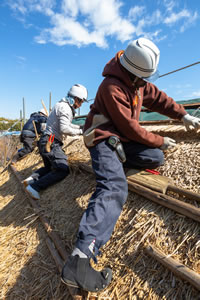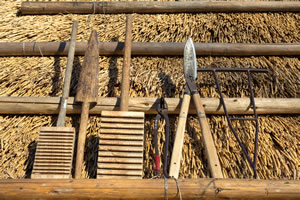
Before World War II, there used to be many thatched-roof residential houses in Japan because thatching works are conducted by the community. After World War II, the Japanese people rebuilt their lives that led to the country’s rapid economic growth. The economic growth, however, took a toll in our culture. Old traditional houses were transformed into Western-inspired houses. What used to be a thatched-roof was changed into galvanized iron roof or brick-roofs. Furthermore, the use of natural roofing materials was limited to heritage sites in accordance with the revised building code. These events had significantly contributed to the decline of the demands for thatch roof works that also resulted in the thatchers’ unemployment. Not only did the thatchers have to deal with unemployment but also their old age that hamper them to train young and potential Japanese thatchers. With the diminishing number of thatchers, old traditional houses’ owners have little or no choice of having their house re-thatched, thus, making hasty decisions to use galvanized aluminum roof instead of water reed. Owners can hardly find thatchers since thatchers they’re familiar with had already passed away and have no inkling on who can substitute.

In Japan’s rural areas, a “hometown” is defined as a place where one can still see preserved culture while coping with the change of time. However, infrastructural development such as conversion of riverbanks (where reed beds are mostly grown) and mountainsides into dams and subdivisions respectively is diminishing the concept of “hometown”. This kind of development serves as one of the reasons we want to promote roof thatching. Another source of inspiration is when I met a person who used to live in a traditional house that conducts preparatory activities such as finding and harvesting of raw materials.
It is important to note that water reed resources are nothing without human interventions. Every year, winter cutting and burning are conducted to ensure that good quality stems are produced. Without such activities, the old and remnant stems are worthless.
Roof thatching is not an easy profession for it requires not only technical knowledge but financial as well. But the most significant aspect is to convey the message that harmonious relationship between man and nature can be achieved by means of roof thatching
It is important to note that water reed resources are nothing without human interventions. Every year, winter cutting and burning are conducted to ensure that good quality stems are produced. Without such activities, the old and remnant stems are worthless.
Roof thatching is not an easy profession for it requires not only technical knowledge but financial as well. But the most significant aspect is to convey the message that harmonious relationship between man and nature can be achieved by means of roof thatching


